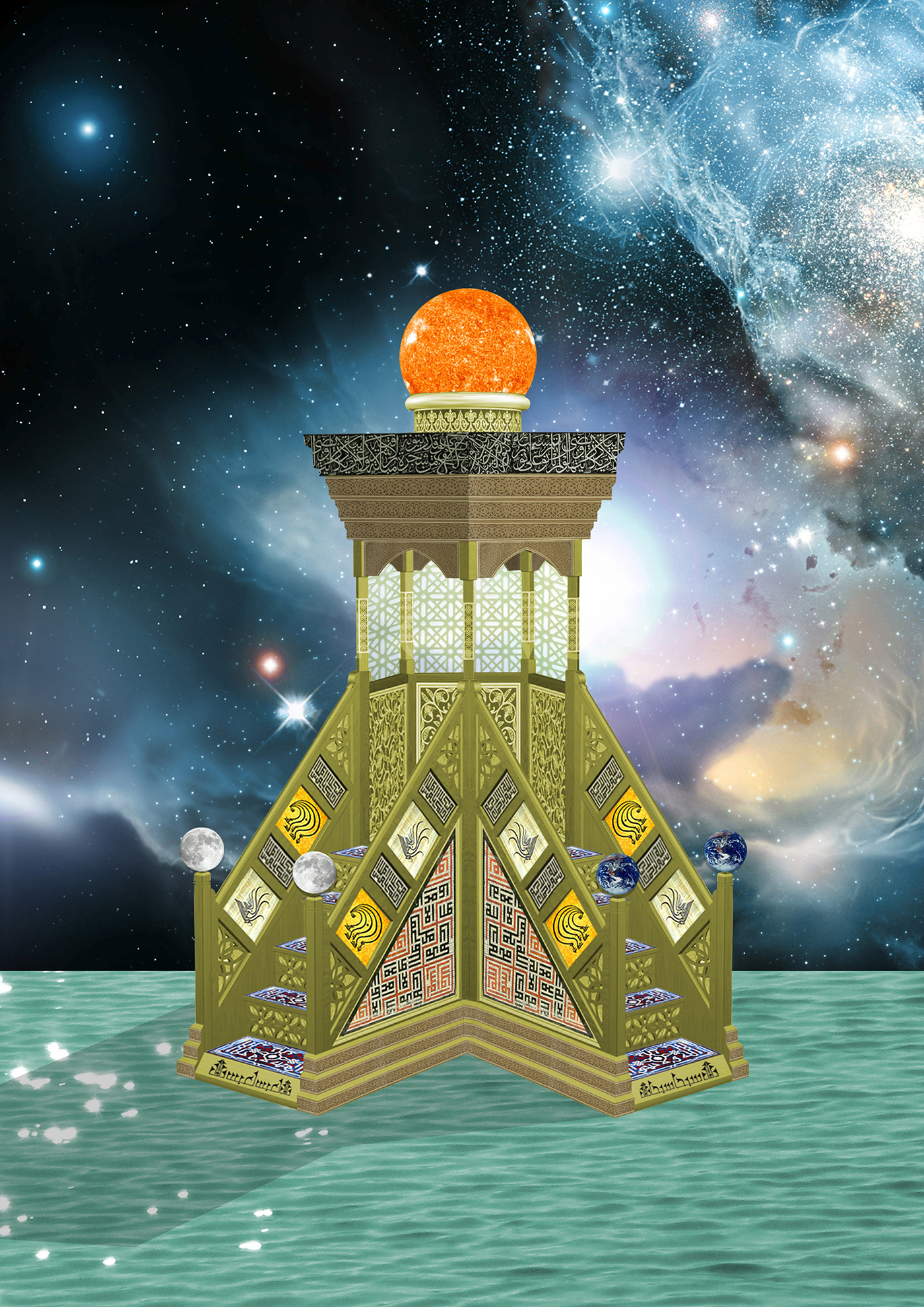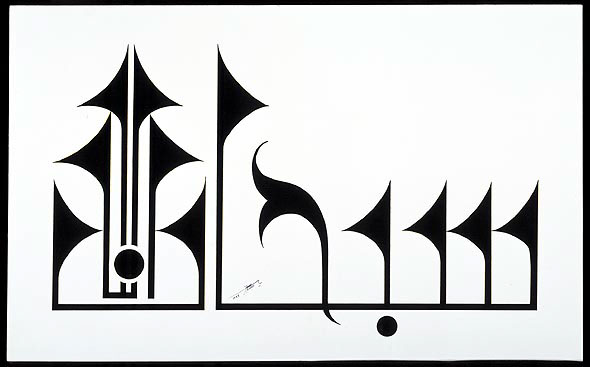
The digital retouching presented below was made while taking classes in Ephemeral Arquitecture -in the Superior School of Arts and Design of Gran Canaria, (Escuela Superior de Arte y Diseño de Gran Canaria) in the year 2011, as part of my study in a Teacher Training Programme. It is a reinterpretation of an element of the Muslim religion called Mimbar, which is a pulpit, or dome, from where the iman recite the preyers.
El retoque digital que pueden ver a continuación se realizó mientras cursaba el CSFP de Arquitectura Efímera en la Escuela de Arte y Superior de Diseño Gran Canaria en el año 2011. Es una reinterpretación de un elemento de la religión musulmana llamado Mimbar, que es un púlpito donde el imán da los sermones.
The Mimbar consists of a raised platform which Access can be only by stairs, as well as their are protected by a door in order to prevent the access of anyone who is not the iman. Incidential mention should be that - as said by the islamic tradition, even that at first sight it may seem that the iman climbs all the stairs, he actually climbs just a few of them inasmuch as Prophet Mohammed is the only one allowed to climb to the top of the Mimbar.
El Mimbar consta de una plataforma elevada a la que se accede por unas escaleras protegidas por una puerta, para evitar que pueda entrar cualquier persona que no sea el imán. Como dato anecdótico hay que puntualizar que aunque a simple vista se pudiera pensar que el imán sube el total de las escaleras para realizar el sermón, el solo puede ascender unos pocos escalones, ya que el único que puede ocupar la plataforma superior es el profeta Mahoma (según la tradición islámica).
The Mimbar is an ephemeral architecture within a conventional architecture, in it begins the second pillar of Islam; prayer. When its doors open and the sermón begins If one raises his view to the part where -according to tradition, the prophet would stand, a bond is generated; in which the imam may feel the presence of Mohammed. There is something mystical in it, difficult to explain and even more so to understand -there is the essence of religion, the creed of believing in something unpalpable whose existence can not be sure. For these reasons, the ephemeral architecture has been created. Its meaning is explained in more detail later.
El Mimbar es una arquitectura efímera dentro de una arquitectura convencional, en ella da comienzo el segundo pilar del Islam, la oración. Al abrir sus puertas el imán sube unos peldaños y comienza el sermón, si asciende su mirada hacia la parte donde según la tradición se colocaría el profeta, se genera un vínculo, en el cuál, puede que el imán sienta la presencia de Mahoma. Sucede algo místico, difícil de explicar y más aún de comprender, aparece la esencia de la religión, el credo de creer en algo no palpable, de cuya existencia no se puede estar seguro. Por estas razones se ha creado la arquitectura efímera adjunta, y a continuación se explica con más detenimiento su significado.
It is not accidental that this structure is placed in the water, almost all the mosques has a religious courtyard known as Sahn, in it is a symmetrical pool and the Howz, where the ablutions are performed. We purify ourselves through the water, before entering the structure. What will await us upon entering?
Que la estructura esté entre agua no es casual, casi todas las mezquitas tiene un patio religioso conocido como Sahn, en él se encuentra una piscina simétrica, el Howz, donde se realizan las abluciones (la purificación ritual…). Por medio del agua nos purificamos antes de entrar a la arquitectura. ¿Qué pasará al entrar?
The first difference between a Mimbar and the element I created, is that it has an entrance and an exit which represent the beginning and the end. The beginning and the end of what? Well, that can only be said by the person who gets into it, as each individual is unique and has his own beliefs.
La primera diferencia entre un Mimbar y el elemento creado, es que este tiene un acceso de entrada y otro de salida, eso es para representar el principio y el fin, ¿de qué? Eso solo lo puede decir la persona que se interna en la arquitectura. Cada individuo es único, con sus propias creencias.
The start poing of the handrail is crowned by representations of the Moon, is an inert satellite -a body that does not harbor life. This form symbolizes that the building is empty before you enter in it -it is incomplete, but when you leave, a possitive change occurs; that's why the lower point of the handrails are crowned by the Earth, a planet exultant of life.
El principio del pasamanos está coronado por representaciones de la Luna, es un satélite inerte, un cuerpo que no alberga vida, de está forma se simboliza que antes de entrar en la arquitectura se está vacío, incompleto y cuando se sale, se produce un cambio positivo, por eso los pasamanos de bajada están coronados por la Tierra, un planeta exultante de vida.
At the pulpit entrance, there is a Kufic calligraphy; the oldest of the different scriptures that form part of this Arab decorative art. By means of this symbology we emphasize the idea of beginning. To the exit it is repeated, with the same purpose, but nuancing its meaning -it is the origin of something; the LIFE.
En la entrada al púlpito se ve una caligrafía cúfica, la más antigua de las diferentes escrituras que forman parte de este arte decorativo árabe. Por medio de está simbología remarcamos la idea de comienzo. A la salida se repite, con el mismo fin, pero matizando su significado, es el origen de algo, y ese algo es la VIDA.

Ceramics have been placed at each step of the staircase, so that the visitor can walk carefully -respecting the work, because you may fall if having the sole of your shoes wet. On the railing of the stairs -between the balusters, we find two basmala inscriptions, which are Islamic ritual formulas with which the azoras begin are usually translated as: "In the name of God, the Clement, the Merciful." They differentiate by the use of ornamental motifs. These formulas have been placed in those constructions to invoke a divine being.
En cada peldaño de la escalera se ha colocado cerámica para que el visitante transite con cuidado, respetando la obra, ya que al tener la suela del calzado mojado corre el riesgo de caerse.
En la barandilla de la escalera, entre los balaustres (barrotes) encontramos dos inscripciones basmala, que son fórmulas rituales islámicas con las que se inician las azoras (capítulos del Corán), se suelen traducir como: “En el nombre de Dios, el Clemente, el Misericordioso” (se diferencian por el uso de motivos ornamentales). Estás fórmulas se han colocado en esos lugares para invocar a un ser divino.

The other calligraphy used, belong to the ancient Kufic style and its use apart from serving with an aesthetic purpose; they are used to emphasize the mysterious character of the room, as the meaning of some of them is not known, and give a significant importance to this geometric motifs.
Las demás caligrafías utilizadas pertenecen al estilo cúfico antiguo y su uso a parte de servir con un fin estético, se emplean para remarcar el carácter misterioso de la estancia, debido a que el significado de algunas de ellas no se conoce y dar una importancia notable a los motivos geométricos de los que se forman esté tipo de caligrafía.

At first sight, it can be seen some abuse of vegetal motifs in the piece. It is due to the attempt of creating a polytheistic environment, since these types of motives are very recurrent in the Christian iconography. Another subtle way of transmitting this idea is through color, asmuch as in the Baroque the gold was the favorite color to cover all the decorative elements. That is something that is still present nowadays, especially in the altarpieces inside the churches. The louvers that cover the upper platform have been created in order to give privacy to the person who is inside the structure and to produce a set of lights in the room. The dome crowning the composition represents our sun star, the largest source of energy discovered so far in the solar system. Those ornaments inside the platform help us to concentrate more at the time of the meditation when we are inside of it. If we take a close look at the ephemeral architecture we will perceive that there are almost no empty spaces -horror vacui, and that it has a repetitive nature in terms of decoration, obtaining in this way an effect of mobility and agitation.
Se puede apreciar a simple vista cierto abuso de motivos vegetales en la pieza. Se debe al intento de crear un ambiente politeísta, ya que este tipo de motivos son muy recurrentes en la iconografía cristiana. Otra forma sutil de transmitir está idea, es por medio del color, porque sobre todo en el Barroco, se optaba por cubrir los elementos decorativos de dorado (hoy en día sigue muy presente, sobre todo en los retablos dentro de las iglesias).
Las celosías que cubren la plataforma superior se han creado con el fin de dar intimidad a la persona que se encuentre situada en su interior y para producir un juego de luces en la estancia.
La cúpula que corona la composición representa nuestro astro rey, el Sol, la mayor fuente de energía descubierta hasta el momento en el sistema solar. Cuando estamos dentro de la plataforma nos transmite empuje para así concentrarnos más a la hora de la meditación.
Si hacemos una mirada en conjunto de la arquitectura efímera percibiremos que no existen casi espacios vacíos (horror vacui) y que tiene un carácter repetitivo en cuanto a la decoración, obteniendo de esté modo un efecto de movilidad y agitación.
Follow me – Sígueme
https://es.linkedin.com/in/raulsocas
https://www.tumblr.com/blog/raulsocas
https://es.pinterest.com/raulsocas
http://issuu.com/raulsocas
https://www.facebook.com/raulsocasramirez
https://twitter.com/RRsocas
http://www.domestika.org/es/raulsocas
https://instagram.com/raulsocas/
https://www.tumblr.com/blog/raulsocas
https://es.pinterest.com/raulsocas
http://issuu.com/raulsocas
https://www.facebook.com/raulsocasramirez
https://twitter.com/RRsocas
http://www.domestika.org/es/raulsocas
https://instagram.com/raulsocas/



